Flags of the Celtic Nations
Find out about the fascinating stories behind each of the Celtic flags.
Ireland/Eire
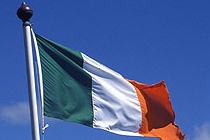
The national flag of Ireland (Irish: bratach na hÉireann) is a vertical tricolour of green white and orange. It has been regarded as the national flag since it was raised above the General Post Office in Dublin during the 1916 Easter Rising. This was the rising of Irish republicans against British rule and the flag has been used by nationalists in the whole of the island of Ireland since then. It was adopted in 1919 by the Irish Republic during its war of independence, then by the Irish Free State (1922 – 1937) and given constitutional status in 1937.
The flags origins date back to 1848. It was presented to Thomas Francis Meagher (August 3 1823 – July 1 1867) when in France by a group who were sympathetic to Irish aspirations for independence. Thomas Francis Meagher was a founder member of the Irish Confederation, an Irish nationalist independence movement formed in 1847.
Isle of Man/Mannin
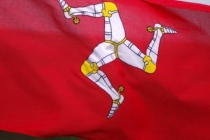
The national flag of the Isle of Man (Manx: Brattagh Vannin). The symbol can be traced back to both Celtic and Norse times. It is associated with Manannán the pre-Christian Celtic god who is part of the Gaelic pantheon of the Tuatha Dé Danann. He was said in oral tradition to race down the Manx mountains on three legs.
The triskele symbol (as found on the Manx flag) is very characteristic of the three interlocked and conjoined spirals found in Celtic art throughout Celtic north western Europe. There are examples of such designs on Neolithic monuments in the Celtic lands, including in the Newgrange passage tomb in Ireland. The design has continued to be used by the Celtic people who are directly descended from their Neolithic ancestors who lived in these lands. It is thought to be a symbol, of life, fertility, the seasons, the universe and regeneration.
Scotland/Alba
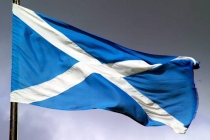
The national flag of Scotland (Scottish Gaelic: Bratach na h-Alba) is a white cross against a blue background. It is known as the Saltire and legend dates its origins back to King Óengus mac Fergusa (Óengus II) who defeated a force of invading Angles in the ninth century. The legend is that in 832 AD the Scottish King prayed to St Andrew for help to defeat the English. Against the blue sky the diagonal white cross appeared and it was on such a cross that St Andrew had been martyred. The English were beaten and St Andrew is the patron saint of Scotland. The association of St Andrew with Scotland goes back further than the reign of King Óengus II to Óengus I who was King from 732 to 761 AD.
The Saltire features as part of the logo of the Scottish Government and the flag is ruled by them to fly whenever possible from its buildings on a daily basis.
Wales/Cymru
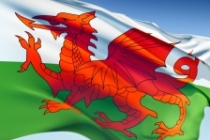
The national flag of Wales (Welsh: Baner Cymru or Y Ddraig Goch) is a red dragon against a green and white background. There are a number of versions of how the red dragon has become the symbol of Wales. In one such story it has been associated with Arthurian legend and the wizard Merlin (Myrddin). Merlin prophesied to King Vortigern (Welsh: Gwrtheyrn) of Wales that the red dragon, being the symbol of the Celts, would defeat the white dragon which was the symbol of the Saxon invaders. The Saxons would then be driven from the land.
Cornwall/Kernow
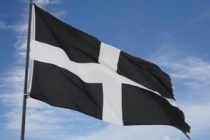
The national flag of Cornwall (Cornish: Baner Peran) is a white cross against a black background. It is attributed to St Piran, now generally accepted as the patron saint of Cornwall. The flag of saint Piran is similar to the flag of St David (Welsh: Baner Dewi Sant), a yellow cross on a black background and the old Breton flag (Breton: Kroaz Du), a black cross against a white background and a symbol of the independent duchy of Brittany. There are clear and close cultural ties between Cornwall, Wales and Brittany.
Cornwall is located on a peninsula in the southwest of the island of Britain. It is one of the six Celtic nations and one of the three that share the island along with Wales and Scotland. The non-Celtic country of England is also located on the island of Britain. One legend of the early 6th century St Piran is that he came to Cornwall from Ireland sailing on a millstone. He is also associated with the metal tin and the flag of St Piran is said to symbolise the white metal flowing from black rock.
Brittany/Breizh
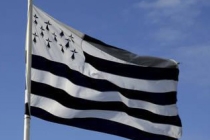
The national flag of Brittany (Breton: Gwenn-ha-du) has nine horizontal alternating black and white stripes with Ermine heraldry as used in the coat of arms of the Duchy of Brittany. The flag is also used in the department Loire-Atlantique. The city of Nantes and the Loire-Atlantique Department were formerly part of the historic land of Brittany and Nantes along with Rennes was one of its traditional capitals. Historically, the country around Nantes was always seen as being part of Brittany. In 1207 the Dukes of Brittany lived in Nantes. Most of the dukes and duchesses were buried in the cathedral or the adjacent abbeys.
Although it was split from the other four departments that remain in Brittany by the French government, the Loire-Atlantique is culturally, historically and geographically united to Brittany. There continues to be active campaigns for the reunification of Brittany.
Pan-Celtic
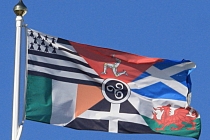
The Pan-Celtic or Inter-Celtic flag is a combination of the flags of the six Celtic nations.
- Pan-Celtic
- English
- Log in to post comments






